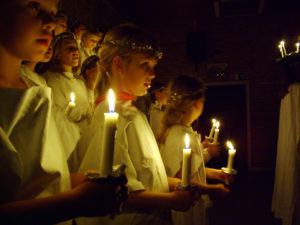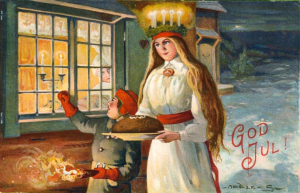December 13, and the solstice of Midwinter is but a week away. Until then, the nights grow deeper, longer, darker. In the midst of that growing darkness, we welcome today the next of the Midwinter gift bearers: Saint Lucy, the light bearer, patron saint of those with vision problems and of the blind. She was from Sicily and so she is sacred to Italy, where she is known as Santa Lucia (pronounced loo-chee-a). But she is perhaps best known in Sweden, of all places, where she is called Sankta Lucia (pronounced with a soft C, loo-see-a). For many in Sweden, breakfast today was served in the darkness, which is long there near the Arctic Circle, by a Lucia dressed in white, walking through the house with a wreath of lit candles upon her head, delivering coffee and saffron buns, lussekatter, to the drowsy household. She is usually the oldest daughter.
Our neighbor old Mr. Solderholm, when his young granddaughter was visiting one winter, told her about the tradition of the Sankta Lucia. She was cool about it and didn’t seem too impressed by his tales of what Decembers used to be like, but she did surprise him all the same the next morning, at his bedroom door, in the still and holy darkness, bearing a flashlight, a Coca-Cola, and two Pop Tarts on a platter. Afterwards, he had a splitting headache clear through to lunchtime, but he could not stop talking about this fine thing that his granddaughter had done for him. It is a lovely thing to have this gift of light bestowed upon you.
In Sweden, where Mr. Solderholm’s family is from, there are processions throughout the country tonight celebrating Sankta Lucia, in churches, in schools, in city streets, on national television. The Lucia will be wearing a crown of lit candles on her head, just like the Lucias that delivered breakfast this morning. The processions can get quite large, with scores of attendants to the Lucia: boys and girls each bearing a candle, and then the Star Boys, each carrying stars on poles and donning huge white conical caps. Everyone is dressed in white––“White,” Jane Siberry says, “the color of truth.” The sounds of the procession are a symphony of bells and the Neapolitan melody “Santa Lucia,” but with Swedish lyrics, my favorite part being Natten går tunga fjät, which translates to “The night walks with heavy steps.” Such a beautiful image, and such a beautiful song. You can feel it warming the air, you can feel it bearing light in the darkness. That light and its spirit is what we wish you on this night of heavy steps. And––if you happen to have a Swedish bakery nearby––we wish you lussekatter, as well.
Image: “Sankta Lucia Procession in Denmark.” Photograph by Per Palmkvist Knudsen, 2006 [Creative Commons via Wikimedia Commons].


